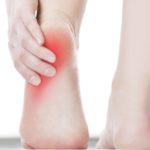Plantar Fasciitis in Runners
Plantar fasciitis is an inflammation of the thick, supportive tissues on the bottom of the foot, and is one of the most common causes of heel pain.
As many as 2 million Americans are affected by plantar fasciitis each year, making it a  problem that affects both competitive and recreational athletes alike. While the precise cause remains unknown, it is thought to result from repetitive microtrauma and inadequate stretching of the plantar fascia, a thick supportive band of connective tissues running between the heel bone and the toes. Plantar fasciitis can affect athletes of virtually every sport, but is particularly common among runners. Overweight people are at a greater risk as well.
problem that affects both competitive and recreational athletes alike. While the precise cause remains unknown, it is thought to result from repetitive microtrauma and inadequate stretching of the plantar fascia, a thick supportive band of connective tissues running between the heel bone and the toes. Plantar fasciitis can affect athletes of virtually every sport, but is particularly common among runners. Overweight people are at a greater risk as well.
This article explores the signs and symptoms of Plantar Fasciitis, as well as preventive measures and treatment options that can reduce the likelihood of further damage and discomfort. Understanding Plantar Fasciitis Symptoms is an essential part of living pain free and allowing your feet to reach their full potential.
Understanding Plantar Fasciitis Symptoms
Athletes with plantar fasciitis symptoms will complain of heel pain that is often worst in the first few steps in the morning, and gradually improves with walking throughout the day. There is also often discomfort along the inner aspect of the foot with flexing the toes upward towards the shin bone (“tibia”). The region at the inner aspect of the heelbone where the plantar fascia attaches is often tender to palpation as well. Plain x-rays may sometimes show a spur in the bone at this location, although they are often normal. MRI or ultrasound of the plantar fascia is usually much more effective in confirming the diagnosis.
Causes of Plantar Fascitis in Runners
Risk factors for developing Plantar Fasciitis can vary, but commonly include having high arches or flat feet, poor foot alignment, obesity, and working jobs that require a great deal of foot movement. Certain footwear can also contribute to the risk, such as shoes without good arch support or proper cushioning, as well as shoes with soles that have little to no shock absorption. Runners should note that over-exertion can increase the risk of developing Plantar Fasciitis. Tight calf muscles and Achilles tendons can cause strain on the plantar fascia, as can foot tilting, and running on hard surfaces or hills. Other conditions, such as shin splints, may heighten a person’s susceptibility to this injury.
Treatments to Relieve Plantar Fasciitis Pain
The first line of treatment is nonsurgical and is usually very effective. Treatments include stretches for the plantar fascia and Achilles tendon, as well as splints for use at night time to keep the foot in a neutral position. Arch support orthotics and taping of the foot can help to provide support and relief with walking as well. Nonsteroidal medications are also effective in helping to relieve severe bouts of inflammation. Corticosteroid injections can also be used but must be done so judiciously, as their overuse can increase the risk of rupture of the plantar fascia and loss of its support in maintaining the arches of the foot. For longstanding cases, shock wave therapy has recently been used with good success. Surgical procedures such as cutting or removing the plantar fascia are reserved for only those refractory cases which have failed to respond to all other interventions.
Preventing Flare-ups and Further Injury
Taking preventative measures to protect and heal from Plantar Fasciitis is essential for runners to have long-term relief and recovery. Without proper precautions, flare-ups and further injury can occur, setting an individual’s progress back and leading to more pain and suffering. With the right steps and techniques, however, flare-ups and further damage can be avoided. From wearing the right footwear to performing regular calf stretches, an assortment of precautionary measures can help protect against irritating flare-ups and further injury.
Stretching and Physical Activity
Exercise is an essential component of any healthy lifestyle, particularly for individuals suffering from plantar fasciitis. Stretching is an essential aspect of physical activity that can help improve range of motion in the feet, legs, hips, and lower back. Regular stretching can help reduce the risk of injury and help people engage in enjoyable physical activities. The beneficial effects of stretching and physical activity are well known and much research has been conducted to further highlight their value. Studies have reported improvements in pain and physical functioning associated with plantar fasciitis when stretching and physical activity are incorporated into treatment plans. Consistent stretching, along with proper warm-up, hydration, and rest, can help individuals with plantar fasciitis achieve long-term relief from their symptoms. Additionally, physical activity can help the body maintain a healthy mass and support a general feeling of well-being. The overall premise is to improve one’s physical activity through stretching which is an important component to sustaining an active and healthy lifestyle. Regular and progressive stretching activities can improve the quality of life for many, particularly those with plantar fasciitis. Doing so is not only beneficial for physical health, but there is evidence that it also offers positive effects for mental and emotional health.
Tips for Living With Plantar Fasciitis
Living with Plantar Fasciitis can be a challenge, but there are steps you can take to reduce discomfort and promote healing. By following the proper advice and taking appropriate precautions, it is possible to lessen the severity of Plantar Fasciitis symptoms, allowing you to continue to lead a productive and active life. Here are some tips to consider if you are dealing with Plantar Fasciitis:
- Wear supportive shoes with a stiff and stable sole. Having a supportive shoe with a rigid sole and deep heel can be beneficial in providing support and helping to spread out the strain on the Plantar Fascia. Ensure the shoe is properly fitted and fits snugly and comfortably with adequate cushioning.
- Increase your activity level gradually. Progressing slowly ahead with your activity level by starting low and gradually increasing will help you to limit the strain placed upon your feet and help prevent flare up from overuse.
- Manage painful symptoms with rest and ice. Taking regular time off your feet and reducing your activity level can help to reduce the pain and inflammation associated with Plantar Fasciitis. Applying ice for short intervals can also help to lessen symptoms.
- Do stretching exercises designed to target the Plantar Fascia. Stretching and strengthening the Plantar Fascia can help to reduce the tension on it, improve mobility and reduce strain. However, it is important to perform the exercises correctly in order to experience real benefits.
- Use orthotic foot supports. Wearing supportive insoles, compression socks or stretching splints can help to reduce the pain and tension on the Plantar Fascia. Over the counter orthotics or customized orthotics may be beneficial depending on your individual needs.
Living with Plantar Fasciitis can be a difficult journey, but being mindful of certain strategies can help make this challenge a bit more manageable. Taking steps to ensure your feet are adequately supported, maintaining an appropriate activity level, managing painful symptoms with rest and ice, performing targeted stretching exercises and possibly utilize orthotics will make a world of difference in reducing discomfort and promoting healing.

